Phase Portraits of Linear Systems
Consider a  linear homogeneous system
linear homogeneous system
 .
We think
of this as describing the motion of a point in the
.
We think
of this as describing the motion of a point in the  plane
(which in this context is called the phase plane), with
the independent variable
plane
(which in this context is called the phase plane), with
the independent variable  as time. The path travelled by the point
in a solution is called a trajectory of the system.
A picture of the trajectories is called a phase portrait of the system.
In the animated version of this page, you can see the moving points
as well as the trajectories. But on paper, the best we can do
is to use arrows to indicate the direction of motion.
as time. The path travelled by the point
in a solution is called a trajectory of the system.
A picture of the trajectories is called a phase portrait of the system.
In the animated version of this page, you can see the moving points
as well as the trajectories. But on paper, the best we can do
is to use arrows to indicate the direction of motion.
In this section
we study the qualitative features of the phase portraits,
obtaining a classification of the different possibilities that can
arise. One reason
that this is
important is because, as we will see shortly,
it will be very useful in the study of nonlinear systems.
The classification will not be quite complete, because we'll leave
out the cases where 0 is an eigenvalue of  .
.
The first step in the classification is to find the characteristic polynomial,
 , which will be a quadratic: we write it as
, which will be a quadratic: we write it as  where
where  and
and  are real numbers (assuming as usual that our matrix
are real numbers (assuming as usual that our matrix  has real entries). The classification will depend mainly on
has real entries). The classification will depend mainly on  and
and  ,
and we make a chart of the possibilities in the
,
and we make a chart of the possibilities in the  plane.
plane.
Now we look at the discriminant of this quadratic,
 . The sign of this determines what type of eigenvalues our
matrix has:
. The sign of this determines what type of eigenvalues our
matrix has:
- If
 , there are two distinct real eigenvalues.
This occurs
below the parabola
, there are two distinct real eigenvalues.
This occurs
below the parabola  in the
in the  plane.
plane.
- If
 , there is one real eigenvalue (a double eigenvalue).
This occurs on the parabola.
, there is one real eigenvalue (a double eigenvalue).
This occurs on the parabola.
- If
 , there are two complex eigenvalues (complex
conjugates of each other). This occurs in the region above the parabola.
, there are two complex eigenvalues (complex
conjugates of each other). This occurs in the region above the parabola.
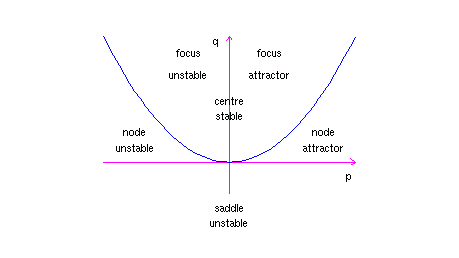
Each of these cases has subcases, depending on the signs (or in the
complex case, the sign of the real part) of the eigenvalues. Note that
 is the product of the eigenvalues (since
is the product of the eigenvalues (since
 ),
so for
),
so for  the sign of
the sign of  determines whether the eigenvalues
have the same sign or opposite sign.
We will ignore the possibility of
determines whether the eigenvalues
have the same sign or opposite sign.
We will ignore the possibility of  , as that would mean 0 is an eigenvalue.
, as that would mean 0 is an eigenvalue.
The sum of the eigenvalues is  ,
so if they have the same sign this is opposite to the sign of
,
so if they have the same sign this is opposite to the sign of  . If the
eigenvalues are complex, their real part is
. If the
eigenvalues are complex, their real part is  .
.
Another important tool for sketching the phase portrait is the following:
an eigenvector  for a real eigenvalue
for a real eigenvalue  corresponds to a solution
corresponds to a solution
 that is always on the ray from the origin in the direction of the eigenvector
that is always on the ray from the origin in the direction of the eigenvector
 . The solution
. The solution
 is on the ray in the opposite direction.
If
is on the ray in the opposite direction.
If  the motion is outward, while if
the motion is outward, while if  it is inward.
As
it is inward.
As  (if
(if  ) or
) or  (if
(if  ), these trajectories
approach the origin, while as
), these trajectories
approach the origin, while as  (if
(if  ) or
) or  (if
(if  ) they go off to
) they go off to  . For complex eigenvalues,
on the other hand, the eigenvector is not so useful.
. For complex eigenvalues,
on the other hand, the eigenvector is not so useful.
In addition to a classification on the basis of what the curves look like,
we will want to discuss the stability of
the origin as an equilibrium point.
- An equilibrium point of a system is a point
 where the system
says
where the system
says  and
and  are both 0. Thus if a solution starts out at an equilibrium point,
it stays there for all time.
are both 0. Thus if a solution starts out at an equilibrium point,
it stays there for all time.
- An equilibrium point is stable if, whenever a solution starts close enough
to that equilibrium point, it stays close forever (i.e. for
 ).
).
- An equilibrium point is unstable if it is not stable. This means that
it is possible for a solution to start arbitrarily close to that equilibrium point
and eventually leave the neighbourhood of that point.
- An equilibrium point is an attractor if every solution that starts
close enough to that equilibrium point approaches it in the limit
 .
Every attractor is stable, but as we will see there are stable
equilibrium points that are not attractors.
.
Every attractor is stable, but as we will see there are stable
equilibrium points that are not attractors.
Here, then, is the classification of the phase portraits of  linear systems.
linear systems.
- If
 ,
,  and
and  , we have two negative eigenvalues.
There are straight-line trajectories corresponding to the eigenvectors.
The other trajectories are curves, which come in to the origin tangent to
the ``slow'' eigenvector (corresponding to the eigenvalue that is closer to 0),
and as they go off to
, we have two negative eigenvalues.
There are straight-line trajectories corresponding to the eigenvectors.
The other trajectories are curves, which come in to the origin tangent to
the ``slow'' eigenvector (corresponding to the eigenvalue that is closer to 0),
and as they go off to  approach the direction of the ``fast'' eigenvector.
approach the direction of the ``fast'' eigenvector.
This case is called a node. It is an attractor.
Here is the picture for
the matrix
 , which has characteristic
polynomial
, which has characteristic
polynomial  . The eigenvalues are
. The eigenvalues are  (slow)
and
(slow)
and  (fast), corresponding to eigenvectors
(fast), corresponding to eigenvectors
 and
and
 respectively.
respectively.
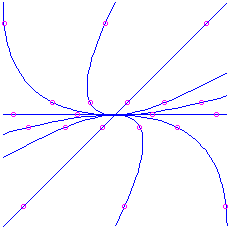
- If
 ,
,  and
and  , we have two positive eigenvalues.
The picture is the same as in the previous case, except with the arrows
reversed (going outward instead of inward).
Again the curved trajectories come in to the origin tangent to
the ``slow'' eigenvector (corresponding to the eigenvalue that is closer to 0),
and as they go off to
, we have two positive eigenvalues.
The picture is the same as in the previous case, except with the arrows
reversed (going outward instead of inward).
Again the curved trajectories come in to the origin tangent to
the ``slow'' eigenvector (corresponding to the eigenvalue that is closer to 0),
and as they go off to  approach the direction of the ``fast''
eigenvector.
This is also a node, but it is unstable.
Here is the picture for
the matrix
approach the direction of the ``fast''
eigenvector.
This is also a node, but it is unstable.
Here is the picture for
the matrix
 , which has characteristic
polynomial
, which has characteristic
polynomial  . The eigenvalues are
. The eigenvalues are  (slow)
and
(slow)
and  (fast), corresponding to eigenvectors
(fast), corresponding to eigenvectors
 and
and
 respectively. Note that the picture is
exactly the same as what we had for the attractor node, except that
the direction of time is reversed (the animation is run backwards).
respectively. Note that the picture is
exactly the same as what we had for the attractor node, except that
the direction of time is reversed (the animation is run backwards).
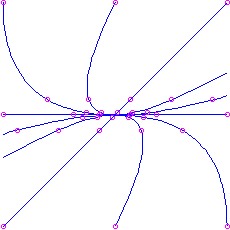
- If
 and
and  , we have one positive and one negative eigenvalue.
Again there are straight-line trajectories corresponding to the eigenvectors,
with the motion outwards for the positive eigenvalue and inwards for the
negative eigenvalue. These are the only trajectories that approach the
origin (in the limit as
, we have one positive and one negative eigenvalue.
Again there are straight-line trajectories corresponding to the eigenvectors,
with the motion outwards for the positive eigenvalue and inwards for the
negative eigenvalue. These are the only trajectories that approach the
origin (in the limit as  for the positive and
for the positive and  for the
negative eigenvalue). The other trajectories are curves that come in from
for the
negative eigenvalue). The other trajectories are curves that come in from
 asymptotic to a straight-line trajectory for the negative eigenvalue,
and go back out to
asymptotic to a straight-line trajectory for the negative eigenvalue,
and go back out to  asymptotic to a straight-line trajectory for the
positive eigenvalue.
asymptotic to a straight-line trajectory for the
positive eigenvalue.
This is called a saddle. It is unstable. Note that if you start on the straight
line in the direction of the negative eigenvalue you do approach the equilibrium
point as  , but if you start off this line (even very slightly) you end up
going off to
, but if you start off this line (even very slightly) you end up
going off to  .
.
Here is the picture for the matrix
 , which has
characteristic polynomial
, which has
characteristic polynomial  . The eigenvalues are
. The eigenvalues are  and
and  ,
corresponding to eigenvectors
,
corresponding to eigenvectors
 and
and
 respectively.
respectively.

- If
 , we have only one eigenvalue
, we have only one eigenvalue  (a
double eigenvalue).
There are two cases here, depending on whether or
not there are two linearly independent eigenvectors for this eigenvalue.
(a
double eigenvalue).
There are two cases here, depending on whether or
not there are two linearly independent eigenvectors for this eigenvalue.
- If there are two linearly independent eigenvectors, every nonzero vector
is an eigenvector. Therefore we have straight-line trajectories in all
directions. The motion is always inwards if the eigenvalue is negative
(which means
 ), or outwards if the eigenvalue is positive (
), or outwards if the eigenvalue is positive ( ).
This is called a singular node. It is an attractor if
).
This is called a singular node. It is an attractor if  and
unstable if
and
unstable if  .
.
Here is the picture for the matrix
 ,
which has characteristic polynomial
,
which has characteristic polynomial  and eigenvalue
and eigenvalue  .
It is unstable. For the matrix
.
It is unstable. For the matrix  we would have an attractor: the
same picture except with time reversed.
we would have an attractor: the
same picture except with time reversed.
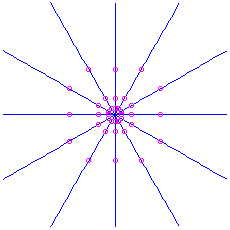
- If there is only one linearly independent eigenvector, there is only one
straight line. The other trajectories are curves, which come in to the origin
tangent to the straight line trajectory and curve around to the opposite
direction. Trajectories on opposite sides of the straight line form an ``S''
shape. The way to tell whether it is a forwards S or backwards S is to
look at the direction of the velocity vector
 at some point off the straight line.
at some point off the straight line.
This is called a degenerate node. Again, it is an attractor if
 and
unstable if
and
unstable if  .
.
Here is the picture for the matrix
 ,
which has characteristic polynomial
,
which has characteristic polynomial  , eigenvalue 1 and
eigenvector
, eigenvalue 1 and
eigenvector
 . It is unstable.
Note that the trajectories above the straight line
. It is unstable.
Note that the trajectories above the straight line  are come out
of the origin heading to the left along that line, and those below the
line come out heading to the right. Thus the S is forwards. To check
this, you could calculate the velocity vector at, for example,
are come out
of the origin heading to the left along that line, and those below the
line come out heading to the right. Thus the S is forwards. To check
this, you could calculate the velocity vector at, for example,
 , which is
, which is
 . Since that points to the right, it's easy to see the S
must be forwards.
. Since that points to the right, it's easy to see the S
must be forwards.
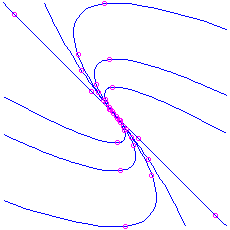
- If
 and
and  , we have complex eigenvalues
, we have complex eigenvalues
 . The solutions are of the form
. The solutions are of the form
 times some combinations of
times some combinations of  and
and  . The picture
is a spiral, also known as a focus. It is an attractor if
. The picture
is a spiral, also known as a focus. It is an attractor if
 , as the factor
, as the factor
 makes all solutions approach the origin
as
makes all solutions approach the origin
as  , and unstable if
, and unstable if  , as in that case the factor
, as in that case the factor
 makes all solutions (except the one starting at the
equilibrium point itself) go off to
makes all solutions (except the one starting at the
equilibrium point itself) go off to  as
as  .
We can calculate a velocity vector to check if the motion is clockwise
or counterclockwise.
.
We can calculate a velocity vector to check if the motion is clockwise
or counterclockwise.
Here is the picture for the matrix
 ,
which has characteristic polynomial
,
which has characteristic polynomial  and eigenvalues
and eigenvalues
 . It is unstable. To check that the motion is clockwise,
you could note that the velocity vector at
. It is unstable. To check that the motion is clockwise,
you could note that the velocity vector at
 is
is
 , which is to the right.
, which is to the right.

- Finally, if
 and
and  , we have pure imaginary
eigenvalues
, we have pure imaginary
eigenvalues
 . The solutions involve combinations of
. The solutions involve combinations of
 and
and
 . These are all periodic,
with period
. These are all periodic,
with period  . The trajectories turn out to be
ellipses centred at the origin. The picture is known as a centre.
Since a solution that starts near the origin just goes around and around
the same ellipse, never getting any closer to or farther from the
equilibrium than the closest and farthest points on the ellipse, this
equilibrium is stable but not an attractor. Again we can calculate a
velocity vector to see whether the motion is clockwise or counterclockwise.
. The trajectories turn out to be
ellipses centred at the origin. The picture is known as a centre.
Since a solution that starts near the origin just goes around and around
the same ellipse, never getting any closer to or farther from the
equilibrium than the closest and farthest points on the ellipse, this
equilibrium is stable but not an attractor. Again we can calculate a
velocity vector to see whether the motion is clockwise or counterclockwise.
Here is the picture for the matrix
 ,
which has characteristic polynomial
,
which has characteristic polynomial  and eigenvalues
and eigenvalues  .
Again you can check that the motion is clockwise by noting that
the velocity vector at
.
Again you can check that the motion is clockwise by noting that
the velocity vector at
 is
is
 ,
which is to the right.
,
which is to the right.
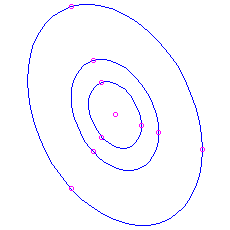
Robert Israel
2002-03-24
![]() .
.
![]() , which will be a quadratic: we write it as
, which will be a quadratic: we write it as ![]() where
where ![]() and
and ![]() are real numbers (assuming as usual that our matrix
are real numbers (assuming as usual that our matrix ![]() has real entries). The classification will depend mainly on
has real entries). The classification will depend mainly on ![]() and
and ![]() ,
and we make a chart of the possibilities in the
,
and we make a chart of the possibilities in the ![]() plane.
plane.
![]() . The sign of this determines what type of eigenvalues our
matrix has:
. The sign of this determines what type of eigenvalues our
matrix has:

![]() is the product of the eigenvalues (since
is the product of the eigenvalues (since
![]() ),
so for
),
so for ![]() the sign of
the sign of ![]() determines whether the eigenvalues
have the same sign or opposite sign.
We will ignore the possibility of
determines whether the eigenvalues
have the same sign or opposite sign.
We will ignore the possibility of ![]() , as that would mean 0 is an eigenvalue.
, as that would mean 0 is an eigenvalue.
![]() ,
so if they have the same sign this is opposite to the sign of
,
so if they have the same sign this is opposite to the sign of ![]() . If the
eigenvalues are complex, their real part is
. If the
eigenvalues are complex, their real part is ![]() .
.
![]() for a real eigenvalue
for a real eigenvalue ![]() corresponds to a solution
corresponds to a solution
![]() that is always on the ray from the origin in the direction of the eigenvector
that is always on the ray from the origin in the direction of the eigenvector
![]() . The solution
. The solution
![]() is on the ray in the opposite direction.
If
is on the ray in the opposite direction.
If ![]() the motion is outward, while if
the motion is outward, while if ![]() it is inward.
As
it is inward.
As ![]() (if
(if ![]() ) or
) or ![]() (if
(if ![]() ), these trajectories
approach the origin, while as
), these trajectories
approach the origin, while as ![]() (if
(if ![]() ) or
) or ![]() (if
(if ![]() ) they go off to
) they go off to ![]() . For complex eigenvalues,
on the other hand, the eigenvector is not so useful.
. For complex eigenvalues,
on the other hand, the eigenvector is not so useful.
![]() linear systems.
linear systems.
 , which has characteristic
polynomial
, which has characteristic
polynomial ![]() . The eigenvalues are
. The eigenvalues are ![]() (slow)
and
(slow)
and ![]() (fast), corresponding to eigenvectors
(fast), corresponding to eigenvectors
![]() and
and
![]() respectively.
respectively.

 , which has characteristic
polynomial
, which has characteristic
polynomial 
![]() , but if you start off this line (even very slightly) you end up
going off to
, but if you start off this line (even very slightly) you end up
going off to ![]() .
.
 , which has
characteristic polynomial
, which has
characteristic polynomial ![]() . The eigenvalues are
. The eigenvalues are ![]() and
and ![]() ,
corresponding to eigenvectors
,
corresponding to eigenvectors
![]() and
and
![]() respectively.
respectively.

 ,
which has characteristic polynomial
,
which has characteristic polynomial ![]() and eigenvalue
and eigenvalue ![]() .
It is unstable. For the matrix
.
It is unstable. For the matrix ![]() we would have an attractor: the
same picture except with time reversed.
we would have an attractor: the
same picture except with time reversed.

![]() and
unstable if
and
unstable if ![]() .
.
 ,
which has characteristic polynomial
,
which has characteristic polynomial ![]() , eigenvalue 1 and
eigenvector
, eigenvalue 1 and
eigenvector
 . It is unstable.
Note that the trajectories above the straight line
. It is unstable.
Note that the trajectories above the straight line ![]() are come out
of the origin heading to the left along that line, and those below the
line come out heading to the right. Thus the S is forwards. To check
this, you could calculate the velocity vector at, for example,
are come out
of the origin heading to the left along that line, and those below the
line come out heading to the right. Thus the S is forwards. To check
this, you could calculate the velocity vector at, for example,
![]() , which is
, which is
 . Since that points to the right, it's easy to see the S
must be forwards.
. Since that points to the right, it's easy to see the S
must be forwards.

 ,
which has characteristic polynomial
,
which has characteristic polynomial ![]() and eigenvalues
and eigenvalues
![]() . It is unstable. To check that the motion is clockwise,
you could note that the velocity vector at
. It is unstable. To check that the motion is clockwise,
you could note that the velocity vector at
![]() is
is
 , which is to the right.
, which is to the right.

 ,
which has characteristic polynomial
,
which has characteristic polynomial ![]() and eigenvalues
and eigenvalues ![]() .
Again you can check that the motion is clockwise by noting that
the velocity vector at
.
Again you can check that the motion is clockwise by noting that
the velocity vector at
![]() is
is
 ,
which is to the right.
,
which is to the right.
